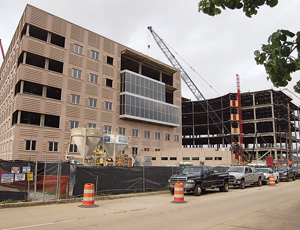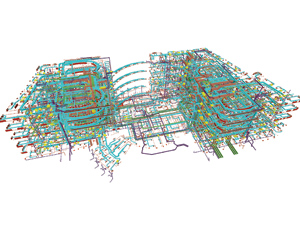The year was 2005. The project was the U.S. Federal Courthouse in Jackson, Miss. The decision, made by the U.S. General Services Administration at the end of design development, was to turn the 400,000-sq-ft facility into a GSA poster child for building information modeling. The design team would create a coordinated BIM and use it to produce 2D contract documents. The team would also provide its BIMs to the construction manager-general contractor, as reference material only, for use during construction.


Many on the design team had never been through a BIM “rodeo.” Yet each design discipline faced converting two years of work to a BIM and then integrating them into a model. “As we got into modeling we quickly learned we had taken on a difficult project,” says Brian Kimsey, professional services division director of GSA’s Southeast Sunbelt Region, in Atlanta.
News of the $300,000 pilot project was received with little enthusiasm from many involved, including the architect, mechanical engineer and the CM-GC, which was already on board in a design-assist capacity but without contractual obligation to use the models. “At first we were skeptical, but we decided to use BIM to utilize work already completed by GSA” and to show the firm’s BIM capabilities for future GSA work, says Allen Reitcheck, project manager for W.G. Yates & Sons Construction Co., Philadelphia, Miss.
The structural engineer was the most eager. “The design was fairly developed and in a way, that made it easier” because there was less remodeling to do, says Jim Jacobi, senior principal for structural engineer Walter P Moore, Houston.
The goals of the BIM pilot were to improve multidisciplinary drawing coordination, streamline estimating, reduce requests for information during construction, reduce change orders, control the schedule, fabricate from design models and minimize cost overruns.
The building is now 50% complete, with 19-plus design BIMs and 60-plus construction BIMs. So far, some goals have been partially met, including model-based design review, coordination and clash detection. Some goals have not been met, including fabrication from design models. Though there is talk about more time spent up front and sharp learning curves, most say they would use or are using BIM again, especially for complex buildings.
The pilot, funded by GSA’s Office of Applied Science, was organized by the courthouse architect, H3 Hardy Collaboration Architecture LLC, New York City. H3 used the funds to cover additional services for training and redocumentation by the design team. H3 also hired a BIM manager to integrate the model and guide the team through many decisions, beginning with selecting a designer BIM platform. The funds also paid for hardware and software upgrades for designers. Some also went to vendors for software consulting and training.
One of the project’s BIM limitations is that trade contractors are not involved early in design. This does not let designers and contractors collaborate on BIM issues before contracts are awarded, says Samir Endamat, director of virtual design and construction for Ghafari Associates, the job’s Dearborn, Mich.-based BIM integrator, who also is involved with Sutter Health’s California hospital.
For example, Jackson-based mechanical engineer Cooke Douglass Farr Lemons had to create its 3D model without knowing which software systems, fabrication standards and technologies the mechanical contractor, which had not yet been selected, was going to use to detail and fabricate ductwork and piping. The design model, though coordinated, is not necessarily compatible with detailing needs. “We now have two models,” which is not efficient, says Emdanat.
The switch to BIM had a major impact on H3, which soon learned it had to revamp its own processes to match the modeling effort. Within its CAD workflow, H3 had divided tasks according to the subject of each sheet in a set of drawings. One team member was responsible for plans and plan details, another for sections and section details and a third for elevations. With those assignments, design changes we re-managed per drawing. Moving a designed wall would require the first team member to change the plan sheets, the second to update the sections and so on. The full repercussions of such a decision were delayed until all drawing updates are completed.
BIM performs that rote work automatically and registers changes in all views. For the Jackson courthouse,...



Post a comment to this article
Report Abusive Comment